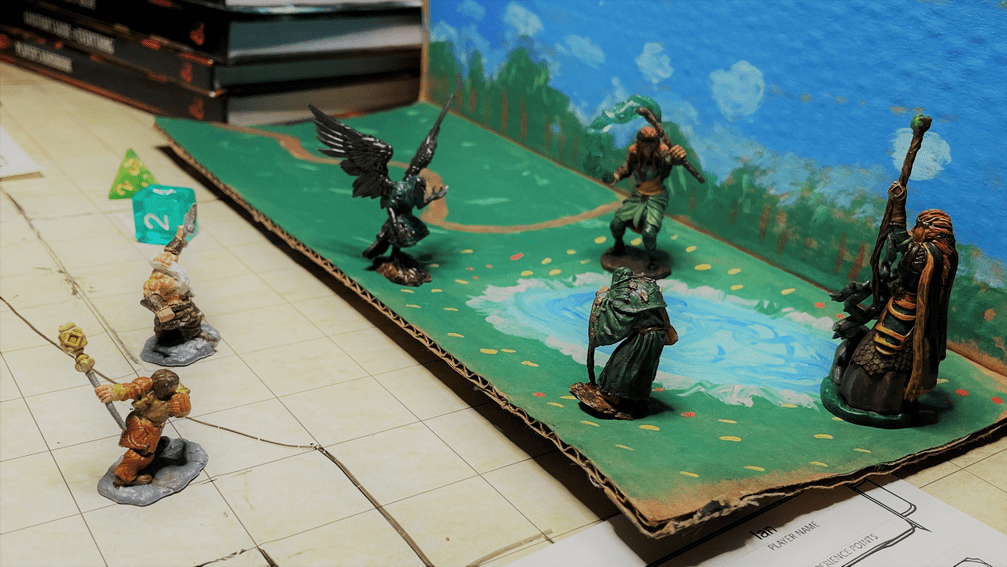In a fight, everyone is constantly watching for a chance to strike an enemy who is fleeing or passing by. Such a strike is called an opportunity attack.
You can make an opportunity attack when a hostile creature that you can see moves out of your reach. To make the opportunity attack, you use your reaction to make one melee attack against the provoking creature. The attack occurs right before the creature leaves your reach.
You can avoid provoking an opportunity attack by taking the Disengage action. You also don’t provoke an opportunity attack when you teleport or when someone or something moves you without using your movement, action, or reaction. For example, you don’t provoke an opportunity attack if an explosion hurls you out of a foe’s reach or if gravity causes you to fall past an enemy.
Opportunity Attack 5e
Opportunity attacks, also known as Attacks of Opportunity (AoO) are an important part of DnD 5e’s combat system. They’re not especially well-liked by players or DMs, since the fear of giving an enemy a “free” attack against you incentivizes creatures to stay in one place once they’re in melee range.
I’ll go over how opportunity attacks work, rules as written, how to avoid them, and why I think DMs should leave them around rather than tinker with a big part of 5e’s basic combat design.
How Do Opportunity Attacks Work in 5e?
Opportunity attacks are a reaction that all creatures have. If a creature moves out of their reach (whatever its melee reach happens to be), it can make a melee attack against that creature. This attack happens right before the creature’s movement; not after.
This only applies if the creature uses its movement, action, or reaction. Forced movement that doesn’t use any of these things (e.g., Thunderwave, the Shove action, etc.) DO NOT trigger opportunity attacks.
Teleporting (e.g., Misty Step, Dimension Door) also DOES NOT trigger opportunity attacks.
The “narrative motivation” for this, according to Jeremy Crawford, is that “forced movement is so sudden that a creature wouldn’t have time to respond” (Sage Advice).
The Disengage action allows you to move without triggering opportunity attacks — that’s the entire point of it.
In short, opportunity attacks are a cornerstone of DnD 5e combat that happen a lot (and are nearly always a threat), as per this Reddit poll:
Importance on opportunity attacks in your game
byu/nAmtAb_68 inDnD
What Are the Rules for Opportunity Attack in 5e?
The rules for Opportunity Attack in DnD 5e are as follows:
-
If you don’t use your action, reaction, or movement to move, you do not trigger an opportunity attack. Here’s a (clearly exasperated) Jeremy Crawford answering this question in 1001 different ways in Twitter thread.
Note, that an ability like Dissonant Whispers, which does use the creature’s reaction to move them, DOES trigger an opportunity attack.
-
With a reach weapon, you can only make an opportunity attack when a creature leaves your reach. For example, if you’re wielding a glaive or a halberd, a creature doesn’t trigger an opportunity attack when it moves 5 feet away from you; only when it moves beyond your 10-foot reach (Sage Advice Compendium, pg. 13).
-
A blinded creature cannot make an opportunity attack, nor can you make an opportunity attack against an invisible creature or a creature you otherwise can’t see. An opportunity attack is only triggered by a creature “you can see” (PHB 195, confirmed in SAC 13).
-
You cannot Shove or Grapple as an opportunity attack. These are special melee attacks that require the Attack action; an opportunity attack is a special reaction, so you cannot use Shove or Grapple in place of it (SAC 13).
-
You cannot make a melee spell attack as an opportunity attack. The War Caster feat allows a way around this (for all single-target spells, not just melee spell attacks), as do some monster abilities that are melee spell attacks that aren’t delivered by spells. But otherwise, an opportunity attack must be a melee attack (SAC 15). This also applies to Booming Blade and Green-flame Blade, which likewise require the Cast a Spell action, and are therefore not eligible for opportunity attacks (again, unless you have War Caster) (SAC 18).
-
Monsters can’t use multiattack for opportunity attacks. They must make a single melee attack, same as players (SAC 21, Monster Manual 11).
-
You only have 1 reaction per turn. So if you use that reaction for something else, like casting Counterspell, you don’t have it available for an opportunity attack. Likewise, you can only make one opportunity attack per round (more specifically, “until the start of your next turn” — read my short article on the topic for more details) (PHB 190).
-
You can use your abilities that relate to melee attacks on an opportunity attack. Stuff like a Paladin’s Divine Smite or a Rogue’s Sneak Attack are able to be used on opportunity attacks. As long as the feature or ability can be used on a melee attack, it can be used on an opportunity attack.
-
A Rogue can Sneak Attack on their turn and another creature’s turn, if it provokes an opportunity attack. Because Sneak Attack can only be used once per “turn,” not once per round (SAC 5).
-
The Sentinel feat freezes a creature before it moves. Because it drops a creature’s speed to 0 when you hit them with an opportunity attack, and an opportunity attack happens before the creature moves.
-
The Polearm Master feat only allows for opportunity attacks when a creature uses its movement, action, or reaction to move into its reach. Same as normal opportunity attacks, but for approaching as well as departing enemies (SAC 9).
-
Command: Flee triggers opportunity attacks. Because “flee isn’t directly harmful; OA may or may not happen,” according to Jeremy Crawford.
-
A Battle Master Fighter can use Riposte from a missed opportunity attack. Sage Advice Compendium, pg. 4.
-
You can make an opportunity attack while you have a readied action (which normally uses your reaction). The only stipulation is that you stop readying that action to do so (SAC 12).
The dissonant whispers spell in the Player’s Handbook is an example of an effect that moves you against your will and can cause you to trigger an opportunity attack, because it uses your reaction to move you. #DnD https://t.co/SYYy4EWYHp
— Jeremy Crawford (@JeremyECrawford) January 20, 2018
How to Avoid Opportunity Attacks in 5e
Here are a few ways to avoid opportunity attack in DnD 5e:
-
Take the Disengage action. This is the base option available to all players and creatures.
-
Be a Rogue. Their 2nd-level feature, Cunning Action, allows them to Disengage for a bonus action, making them far more mobile in combat.
-
Be a Monk. They can use 1 Ki point on Step of the Wind, which allows them to Disengage as a bonus action.
-
Be a Swashbuckler Rogue. Their 3rd-level feature, Fancy Footwork, allows them to not provoke opportunity attacks from creatures they attack on their turn, whether the attack lands or not. Their 9th-level feature, Panache, can charm a creature with a successful Persuasion check contested by the target’s Insight check; if you win, the creature can’t take opportunity attacks against anyone but you.
-
Be a Scout Rogue. Their 3rd-level feature, Skirmisher, allows them to move half their speed as a reaction when an enemy ends their turn within 5 feet of them, which doesn’t provoke opportunity attacks.
-
Eagle Totem Barbarian. 3rd-level Totem Spirit feature; during rages, creatures have disadvantage on opportunity attacks against you.
-
Battle Master Fighter. Maneuvering Attack allows you to command a creature to move (half its speed) away from a creature you attacked, and this movement doesn’t provoke an opportunity attack.
-
Hunter Ranger. 7th-level Defensive Tactics (Escape the Horde) feature causes creatures to have disadvantage on opportunity attacks against you.
-
Storm Sorcerer. 1st-level Tempestuous Magic feature allows you fly 10 feet without provoking opportunity attacks as a bonus action after casting a leveled spell.
-
Get the Mobile feat. It allows you to not provoke opportunity attacks from creatures they attack on your turn, whether the attack lands or not.
-
Teleport. The 2nd-level Misty Step spell is the most common example, but an Echo Knight Fighter’s ability to switch places with its Echo also works.
-
Shove or use a forced movement effect on your ally. This doesn’t help you, but it can help your ally. If you force their movement without using their action or reaction (e.g., shove them, use the Thorn Whip spell, etc.), it won’t provoke opportunity attacks. It will eat up your action, though.
5e Feats Related to Opportunity Attacks
-
Sentinel. Allows you to make an opportunity attack even if a creature disengages, brings a creature’s speed to 0 if you hit it with an opportunity attack, and can make opportunity attacks against a creature within reach that attacks a creature other than you.
-
Polearm Master. Allows you to make an opportunity attack when a creature enters your reach. This pairs very, very well with reach weapons and the Sentinel feat, since you can freeze an enemy who’s trying to approach you for a melee attack before they can get in range.
-
War Caster. Allows you to use single-target spells with a casting time of 1 action instead of a melee attack for your opportunity attacks. This pairs especially well Booming Blade.
-
Mobile. Prevents a creature from taking an opportunity attack if you attack it (even if the attack misses) for that turn.
Opportunity Attack 5e DM Tips
Some people don’t like opportunity attacks, but it should be noted that MOST players/DMs think they’re fine — check out this Reddit poll for proof:
Posts from the dndnext
community on Reddit
Also note that some class features, like a Rogue’s Cunning Action, are effectively nerfed if you nerf or otherwise change opportunity attacks. Plus, opportunity attacks (and the threat of them) are one of the things that allows a character to “tank” — an enemy won’t run to chase the squishy backline if they’ll take a free hit from the Paladin to do so.
Basically, opportunity attacks might not be the most elegant game design, and some prefer Pathfinder’s system where only some creatures/players have access to them, but altering them creates more problems than it solves for a 5e game.

![How Many Opportunity Attacks Per Round in 5e? [DnD Quick Guide] fire-giant-mini-dnd-5e](https://www.dndlounge.com/wp-content/uploads/2023/04/fire-giant-mini-dnd-5e-300x169.png)


![Help Action 5e [DnD Rule Guide] myconid-minis-dnd-5e](https://www.dndlounge.com/wp-content/uploads/2023/04/myconid-minis-dnd-5e-300x169.png)